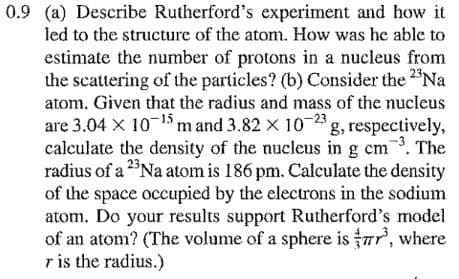(a) Describe Rutherford's experiment and how it led to the structure of the atom. How was he able to estimate the number of protons in a nucleus from the scattering of the particles? (b) Consider the 2Na atom. Given that the radius and mass of the nucleus are 3.04 X 10-15m and 3.82 x 1024 g, respectively, calculate the density of the nucleus in g cm. The radius of a 2Na atom is 186 pm. Calculate the density of the space occupied by the electrons in the sodium atom. Do your results support Rutherford's model of an atom? (The volume of a sphere is r, where r is the radius.)
(a) Describe Rutherford's experiment and how it led to the structure of the atom. How was he able to estimate the number of protons in a nucleus from the scattering of the particles? (b) Consider the 2Na atom. Given that the radius and mass of the nucleus are 3.04 X 10-15m and 3.82 x 1024 g, respectively, calculate the density of the nucleus in g cm. The radius of a 2Na atom is 186 pm. Calculate the density of the space occupied by the electrons in the sodium atom. Do your results support Rutherford's model of an atom? (The volume of a sphere is r, where r is the radius.)
Chemistry & Chemical Reactivity
10th Edition
ISBN:9781337399074
Author:John C. Kotz, Paul M. Treichel, John Townsend, David Treichel
Publisher:John C. Kotz, Paul M. Treichel, John Townsend, David Treichel
Chapter7: The Structure Of Atoms And Periodic Trends
Section: Chapter Questions
Problem 82SCQ
Related questions
Question

Transcribed Image Text:0.9 (a) Describe Rutherford's experiment and how it
led to the structure of the atom. How was he able to
estimate the number of protons in a nucleus from
the scattering of the particles? (b) Consider the 2"Na
atom. Given that the radius and mass of the nucleus
are 3.04 X 10-1 m and 3.82 x 10-2 g, respectively,
calculate the density of the nucleus in g cm. The
radius of a 2Na atom is 186 pm. Calculate the density
of the space occupied by the electrons in the sodium
atom. Do your results support Rutherford's model
of an atom? (The volume of a sphere is r, where
r is the radius.)
Expert Solution
This question has been solved!
Explore an expertly crafted, step-by-step solution for a thorough understanding of key concepts.
This is a popular solution!
Trending now
This is a popular solution!
Step by step
Solved in 6 steps with 6 images

Knowledge Booster
Learn more about
Need a deep-dive on the concept behind this application? Look no further. Learn more about this topic, chemistry and related others by exploring similar questions and additional content below.Recommended textbooks for you

Chemistry & Chemical Reactivity
Chemistry
ISBN:
9781337399074
Author:
John C. Kotz, Paul M. Treichel, John Townsend, David Treichel
Publisher:
Cengage Learning

Chemistry & Chemical Reactivity
Chemistry
ISBN:
9781133949640
Author:
John C. Kotz, Paul M. Treichel, John Townsend, David Treichel
Publisher:
Cengage Learning

General Chemistry - Standalone book (MindTap Cour…
Chemistry
ISBN:
9781305580343
Author:
Steven D. Gammon, Ebbing, Darrell Ebbing, Steven D., Darrell; Gammon, Darrell Ebbing; Steven D. Gammon, Darrell D.; Gammon, Ebbing; Steven D. Gammon; Darrell
Publisher:
Cengage Learning

Chemistry & Chemical Reactivity
Chemistry
ISBN:
9781337399074
Author:
John C. Kotz, Paul M. Treichel, John Townsend, David Treichel
Publisher:
Cengage Learning

Chemistry & Chemical Reactivity
Chemistry
ISBN:
9781133949640
Author:
John C. Kotz, Paul M. Treichel, John Townsend, David Treichel
Publisher:
Cengage Learning

General Chemistry - Standalone book (MindTap Cour…
Chemistry
ISBN:
9781305580343
Author:
Steven D. Gammon, Ebbing, Darrell Ebbing, Steven D., Darrell; Gammon, Darrell Ebbing; Steven D. Gammon, Darrell D.; Gammon, Ebbing; Steven D. Gammon; Darrell
Publisher:
Cengage Learning

Chemistry for Engineering Students
Chemistry
ISBN:
9781337398909
Author:
Lawrence S. Brown, Tom Holme
Publisher:
Cengage Learning

Chemistry: Principles and Reactions
Chemistry
ISBN:
9781305079373
Author:
William L. Masterton, Cecile N. Hurley
Publisher:
Cengage Learning

Introduction to General, Organic and Biochemistry
Chemistry
ISBN:
9781285869759
Author:
Frederick A. Bettelheim, William H. Brown, Mary K. Campbell, Shawn O. Farrell, Omar Torres
Publisher:
Cengage Learning